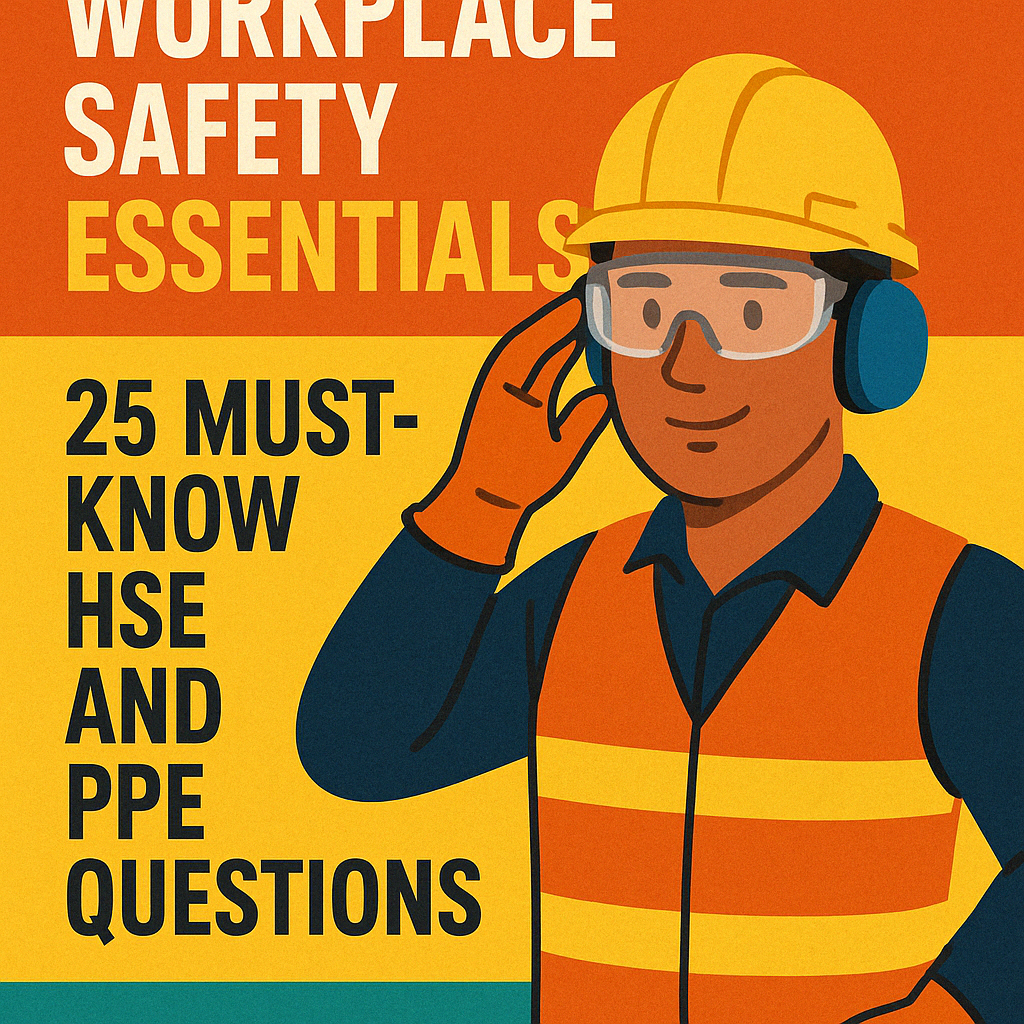Workplace Safety : mHere’s a comprehensive Q&A set of 25 essential occupational health and safety questions and answers, designed to build foundational understanding of Personal Protective Equipment (PPE), safety practices, and Health, Safety, and Environment (HSE) objectives.
This is ideal for training, workplace posters, or awareness materials.
- 1. What are the 7 types of PPE?
- 2. What are the objectives of HSE (Health, Safety, and Environment)?
- 3. Which items are considered a safety hazard?
- 4. What are the essential safety equipment?
- 5. What are health safety items?
- 6. What is an example of a health and safety factor?
- 7. What are 10 personal protective equipment and their uses?
- 8. What are the 5 things of safety?
- 9. What are 4 safety equipment?
- 10. What are the 5 types of safety?
- 11. Why is PPE important in the workplace?
- 12. What is meant by hazard identification?
- 13. What is a risk assessment?
- 14. What is the hierarchy of hazard control?
- 15. What are workplace safety signs used for?
- 16. What are common examples of PPE in construction?
- 17. What is an MSDS or SDS?
- 18. What are common injuries in unsafe workplaces?
- 19. What should be in a workplace first aid kit?
- 20. What is lockout/tagout?
- 21. What are leading indicators in safety?
- 22. What is the importance of emergency exits?
- 23. What is workplace ergonomics?
- 24. How does stress impact workplace safety?
- 25. What is a safety culture?
1. What are the 7 types of PPE?
The seven common types of PPE include:
- Head protection – Helmets, hard hats
- Eye protection – Safety goggles, face shields
- Hearing protection – Earplugs, earmuffs
- Respiratory protection – Masks, respirators
- Hand protection – Gloves (chemical, heat-resistant, etc.)
- Body protection – Coveralls, high-visibility clothing
- Foot protection – Steel-toe boots, slip-resistant shoes
2. What are the objectives of HSE (Health, Safety, and Environment)?
- Prevent workplace injuries and illnesses
- Promote health and well-being of workers
- Protect the environment from work-related harm
- Ensure compliance with occupational laws and regulations
- Create a proactive safety culture
3. Which items are considered a safety hazard?
- Spills or wet floors
- Unshielded machinery
- Exposed wiring
- Blocked fire exits
- Improperly stored chemicals
- Falling objects or unsecured loads
4. What are the essential safety equipment?
- Fire extinguishers
- First aid kits
- PPE (helmets, gloves, masks, etc.)
- Emergency eyewash stations
- Smoke detectors
5. What are health safety items?
- Surgical or N95 masks
- Safety gloves
- Eye wash bottles
- Body sanitizers or disinfectants
- Safety signage
6. What is an example of a health and safety factor?
A common factor is ergonomic workstation design, which reduces strain injuries. Others include air quality, noise levels, lighting, and worker training.
7. What are 10 personal protective equipment and their uses?
- Hard Hat – Head injury prevention
- Goggles – Protect eyes from debris
- Face Shield – Full-face protection
- N95 Respirator – Prevents inhalation of airborne hazards
- Gloves – Protect against chemicals or cuts
- Steel-Toe Boots – Prevent foot injuries
- High-Vis Vest – Improve worker visibility
- Earplugs – Reduce noise exposure
- Coveralls – Shield against chemical splashes
- Fall Harness – Prevent falls from height
8. What are the 5 things of safety?
- Awareness of risks
- Use of PPE
- Training and education
- Housekeeping and cleanliness
- Proper equipment usage
9. What are 4 safety equipment?
- Fire extinguisher
- PPE
- First aid kit
- Emergency exit signs
10. What are the 5 types of safety?
- Occupational safety
- Fire safety
- Electrical safety
- Chemical safety
- Environmental safety
11. Why is PPE important in the workplace?
PPE acts as a barrier between the worker and hazards, minimizing the risk of injury or illness.
12. What is meant by hazard identification?
It’s the process of recognizing potential sources of harm in a workplace.
13. What is a risk assessment?
A structured process to evaluate the likelihood and consequences of hazards causing harm.
14. What is the hierarchy of hazard control?
- Elimination
- Substitution
- Engineering controls
- Administrative controls
- PPE
15. What are workplace safety signs used for?
They communicate dangers and required precautions clearly and quickly.
16. What are common examples of PPE in construction?
- Hard hats
- Steel-toe boots
- Reflective vests
- Safety goggles
17. What is an MSDS or SDS?
Material Safety Data Sheet (MSDS), now called Safety Data Sheet (SDS), provides information about chemical products and their safe handling.
18. What are common injuries in unsafe workplaces?
- Slips, trips, and falls
- Burns and cuts
- Respiratory problems
- Repetitive strain injuries
19. What should be in a workplace first aid kit?
- Bandages
- Antiseptic wipes
- Tweezers
- Eye wash
- Burn cream
20. What is lockout/tagout?
A safety procedure used to ensure machines are properly shut off and not started up again during maintenance.
21. What are leading indicators in safety?
Metrics that predict future incidents, like near-miss reports, training completion, or equipment checks.
22. What is the importance of emergency exits?
They provide a safe route for escape during fires or other emergencies.
23. What is workplace ergonomics?
The science of designing tasks, equipment, and workspace to suit the user, minimizing discomfort and risk of injury.
24. How does stress impact workplace safety?
Stressed workers are more prone to mistakes, fatigue, and poor decision-making, increasing accident risks.
25. What is a safety culture?
A workplace culture where safety is prioritized in all actions, decisions, and attitudes—from leadership to frontline staff.

